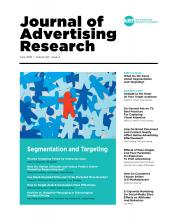ABSTRACT
Significant resources have been devoted to educating the public about the danger of driving under the influence of alcohol, including antidrunk-driving advertising. Most messages have struck a negative tone and resorted to fear appeals, which have limitations and can be ineffectual under certain conditions or for certain target groups of people. In other domains, researchers have shown that a positive message can be more powerful and effective than a negative message. This research focuses on the relative persuasiveness of positive versus negative antidrunk-driving messages and examines the effectiveness of highlighting different types of consequences of drunk driving.
- Received February 7, 2017.
- Received (in revised form) August 28, 2017.
- Accepted October 10, 2017.
- Copyright© 2019 ARF. All rights reserved.
ARF MEMBERS
If you are a member of the Advertising Research Foundation, you can access the content by logging in here
Log In
Pay Per Article - You may access this article (from the computer you are currently using) for 30 days for US$20.00
Regain Access - You can regain access to a recent Pay per Article purchase if your access period has not yet expired.





